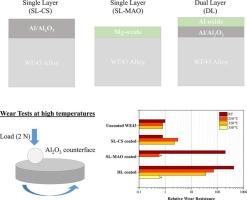Surface modification of WE43 Mg alloy via combination of cold spray and micro-arc oxidation for wear related applications at high temperatures
IF 5.3
2区 材料科学
Q1 MATERIALS SCIENCE, COATINGS & FILMS
引用次数: 0
Abstract
This study investigates the high temperature wear behaviour of a WE43 Mg alloy after covering it with single and dual layer coatings. For this purpose, cold spray and micro-arc oxidation processes were employed individually and sequentially. Single-layer coatings fabricated by cold spray and micro-arc oxidation processes were Al/Al2O3 composite and MgO-based ceramic, respectively. Sequential application of cold spray and micro arc oxidation processes induced dual layer coating upon synthesizing an external Al2O3–based layer over the Al/Al2O3 composite layer. Results of the wear tests conducted under the load of 2 N revealed the superior resistance of the dual layer coated sample against the rubbing action of the counterface compared to single layer coatings. Thus, the presence of a relatively hard and tough external Al2O3-based layer over the Al/Al2O3 composite layer sustained protection up to the temperature of 320 °C, where the dominant wear mechanism was fatigue wear. However, the increase in the test temperature to 350 °C caused detachment of the external Al2O3-based layer. Reduction of the wear test load from 2 to 1 N resulted in the remaining of external Al2O3-based layer intact with the underlying Al/Al2O3 composite layer even at a test temperature of 350 °C. It is therefore concluded that the combination of cold spray and micro-arc oxidation processes is promising to broaden the reliable use of WE43 and other Mg alloys in wear related applications at high service temperatures.

通过冷喷涂和微弧氧化相结合的方法对 WE43 Mg 合金进行表面改性,用于高温下的磨损相关应用
本研究探讨了 WE43 镁合金在覆盖单层和双层涂层后的高温磨损特性。为此,分别采用了冷喷和微弧氧化工艺。通过冷喷涂和微弧氧化工艺制作的单层涂层分别是 Al/Al2O3 复合材料和氧化镁基陶瓷。在 Al/Al2O3 复合材料层上合成外部 Al2O3 基层后,冷喷涂和微弧氧化工艺的连续应用产生了双层涂层。在 2 N 负荷下进行的磨损测试结果表明,与单层涂层相比,双层涂层样品具有更强的抗摩擦力。因此,在 Al/Al2O3 复合材料层上有一层相对坚硬和韧性较强的 Al2O3 基外层,可以在 320 °C 的温度下持续提供保护,在这种温度下,主要的磨损机制是疲劳磨损。然而,当试验温度升高到 350 ℃ 时,外部 Al2O3 基复合层会脱落。将磨损测试载荷从 2 牛顿降低到 1 牛顿后,即使在 350 ℃ 的测试温度下,外部的 Al2O3 基层仍与底层的 Al/Al2O3 复合材料层保持完整。因此,冷喷和微弧氧化工艺的结合有望扩大 WE43 和其他镁合金在高使用温度下磨损相关应用中的可靠使用范围。
本文章由计算机程序翻译,如有差异,请以英文原文为准。
求助全文
约1分钟内获得全文
求助全文
来源期刊

Surface & Coatings Technology
工程技术-材料科学:膜
CiteScore
10.00
自引率
11.10%
发文量
921
审稿时长
19 days
期刊介绍:
Surface and Coatings Technology is an international archival journal publishing scientific papers on significant developments in surface and interface engineering to modify and improve the surface properties of materials for protection in demanding contact conditions or aggressive environments, or for enhanced functional performance. Contributions range from original scientific articles concerned with fundamental and applied aspects of research or direct applications of metallic, inorganic, organic and composite coatings, to invited reviews of current technology in specific areas. Papers submitted to this journal are expected to be in line with the following aspects in processes, and properties/performance:
A. Processes: Physical and chemical vapour deposition techniques, thermal and plasma spraying, surface modification by directed energy techniques such as ion, electron and laser beams, thermo-chemical treatment, wet chemical and electrochemical processes such as plating, sol-gel coating, anodization, plasma electrolytic oxidation, etc., but excluding painting.
B. Properties/performance: friction performance, wear resistance (e.g., abrasion, erosion, fretting, etc), corrosion and oxidation resistance, thermal protection, diffusion resistance, hydrophilicity/hydrophobicity, and properties relevant to smart materials behaviour and enhanced multifunctional performance for environmental, energy and medical applications, but excluding device aspects.
 求助内容:
求助内容: 应助结果提醒方式:
应助结果提醒方式:


